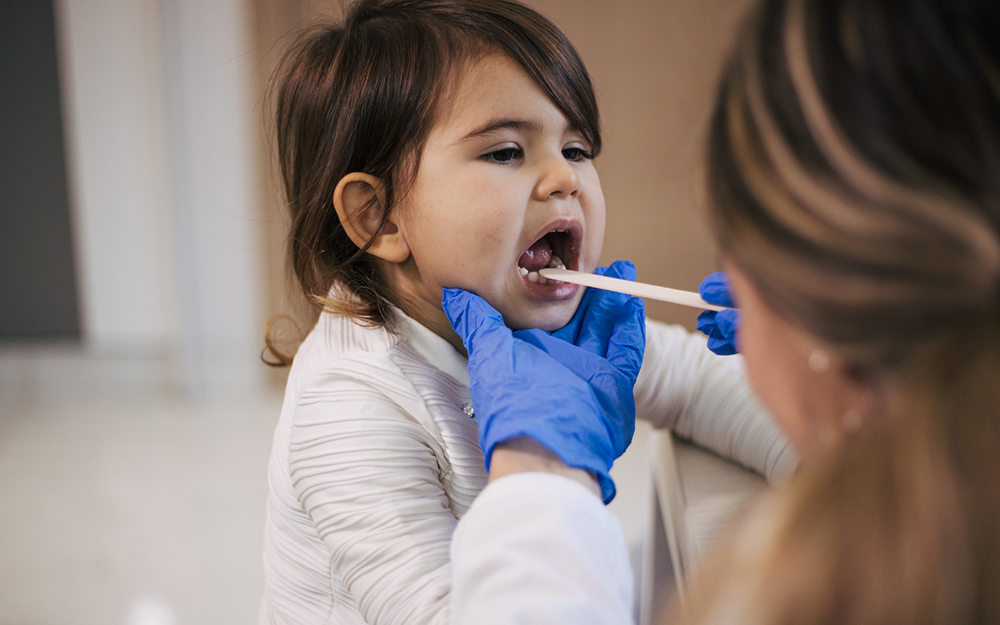Promoting a Positive Body Image in Children
Date
January 4, 2023
Credits

Date
January 4, 2023
Credits
Medical providers featured in this article
In Brief
{{cta-block}}
When your child looks in the mirror, are they comfortable with what they see?
The answer can impact their mental and physical health and lifestyle, including how active they are and their risk for an eating disorder. Nearly half—an estimated 45%—of children and teens have body image issues, according to the National Institutes of Health.
Weight and health are complex, and the stakes are high. Obesity affects about 14.7 million children and teens in the U.S., Centers for Disease Control and Prevention (CDC) figures show, and spiked during the COVID-19 pandemic. Excess weight in childhood is linked to high blood pressure, Type 2 diabetes, heart disease, breathing problems and metabolic disorders.
"The number on the scale is not the be-all, end-all."
At the same time, another crisis is wreaking havoc: pediatric eating disorders. The proportion of teen girls with eating disorders visiting emergency departments doubled during the pandemic, the CDC reports. Eating disorders such as anorexia are the deadliest mental illnesses, jeopardizing the heart, blood, brain, digestive tract and bones.
While these are serious crises, don’t be intimidated, stresses Cedars-Sinai pediatrician Dr. Stephanie Byrne.
Parents play a key role in how their kids and teens feel about their bodies and can empower them to care for themselves, while developing a positive body image.
Keep an open line of communication
“Weight is a very taboo topic, and not talking about it makes it almost impossible for a child to handle things,” Dr. Byrne says.
It should always be a positive conversation, she suggests.
If they say they don’t like how they look or are feeling chubby, don’t ignore it. Ask your child or teen why, then offer some of these solutions below.
Weight and diet are closely intertwined with mental health.
Many people excessively snack “for comfort” when anxious, stressed or depressed, such as during the early parts of the pandemic when schools sent students home and unhealthy foods were within easy reach. Others undereat when struggling psychologically.
Pay close attention when you suspect your child might be using food to suppress their emotions. Set limits—and work together to identify and address the underlying mental health cause, which could be anxiety or social isolation.
Prioritize your child’s wellbeing
Your child’s weight will likely fluctuate over time as they grow and mature.
“The number on the scale is not the be-all, end-all,” Dr. Byrne says.
Neither is body mass index, or BMI, which is determined by a person’s weight divided by the square of their height, categorized into underweight, healthy weight, overweight and obesity.
BMI can be a helpful tool for evaluating health, potential weight-related risks and where they stand in relation to peers, she adds—but it needs to be considered in context.
Pediatricians look at weight assessments alongside a range of factors, including body temperature, breathing, pulse and blood pressure.
And BMI can be overly simplistic. The measurement doesn’t factor in muscle mass, which can give healthy athletes and older teens an inaccurately high result.
Health also looks different for each person: Some families are prone to a certain height, weight or body type.
“However, no genetics makes for certain that someone is going to have a high BMI,” Dr. Byrne explains. “It might make it easier for that to happen or harder to maintain a healthy weight—but it’s not inevitable.”
Food is fuel
Nutritious diets allow bodies and brains to reach their full potential.
They’re also the best way to manage weight, says Dr. Byrne, and gain control of related health conditions, such as diabetes.
For people 2 years or older, federal dietary guidelines suggest:
- A mixture of fruits and vegetables
- Whole grains, such as oatmeal or whole wheat bread
- Diverse proteins, including seafood, beans, lentils and poultry, not just meats
- Fat-free and low-fat dairy
- More water
- Oils
- Curbing solid fats, added sugars (like in sweetened soda and fruit juices) and sodium
Encourage a healthy relationship with food early, when eating habits first form.
Pickiness is common between 3 and 5 years old, Dr. Byrne says. When parents see toddlers ignoring certain foods, many cave and make something else they know their kids will eat.
"That’s a slippery slope and setting them up to have more difficulty maintaining a healthy diet as an older child or adult,” she says.
Instead, make just one meal for the whole family.
“That teaches them that healthy food is not always the fast comfort food, but we eat it because it’s so good for our bodies—and we all, as a family, want to be the healthiest we can be,” Dr. Byrne explains.
Clarifying that connection—and not just dictating rules—is crucial to ensuring they still seek out balanced meals when they’re older.
Don’t force your child to finish their whole plate, public health experts suggest. Guide them to listen to their bodies and recognize when they’re full, which can help prevent future overeating.
Skipping meals should not be an option either. Eat together, so you can keep an eye on any problem areas, such as dieting in teens.
When to see a pediatrician
Follow up with a pediatrician if you notice your child is still struggling with food, despite your best efforts. The pediatrician will evaluate your child and might suggest more frequent follow-up visits to address overeating or undereating.
Based on their physical and mental health, the pediatrician may also refer them to a psychiatrist, psychologist or nutritionist to work on any underlying self-esteem and dietary issues.
“Early intervention is crucial in these situations to prevent long-lasting psychological impact and disordered eating,” Dr. Byrne says.
“The younger that a child is when they develop disordered habits, the harder it is to treat.”
Exercise is essential for growing bodies
The Department of Health and Human Services recommends at least an hour of daily exercise for all children 6 to 17 years old. Physical activity should be moderate to vigorous, with a focus on bone strength in the years leading up to and during puberty—when the most bone growth occurs.
Any movement counts, Dr. Byrne says—dancing, walking, playing kickball or organized sports, such as soccer or basketball.
“The best exercise is something a child loves, because they’re going to want to do it and it’s not going to be a battle,” she stresses.
Help kids find joy in moving their bodies at every size and shape—and not see it as a punishment.
Be careful with family and social pressure
Society often pushes unrealistic, shifting beauty ideals.
“It’s subconscious pressure,” Dr. Byrne says.
And it’s even harder in the modern world, where social media constantly fuels comparisons and can damage teens’ self-esteem across all genders.
If possible, ask your teen to show or tell you what they look at on social media.
Some content promotes harmful relationships to food and weight, such as TikTok trends sharing what users eat in a day or how to cut calories or skip meals without fainting.
Also consider friends, because peers who struggle with food can influence your child’s views.
Still, your child is most likely to internalize the messages they hear at home—from parents and caregivers.
“We need to reframe this toxic vocabulary and place an emphasis on doing things to improve our health, not our appearance,” Dr. Byrne says.
Avoid shaming your own body. That means not talking about restricting foods or not liking the way certain clothes look on you.
Conversations about family, friends or neighbors gaining or losing weight can reinforce misconceptions about thinness being good and overweight being bad.
Weight loss shouldn’t be praised as an end goal.
Consistently emphasize that your child’s size doesn’t define them or their value, Dr. Byrne says. What matters is who they are, their treatment of others and how they spend their days.





